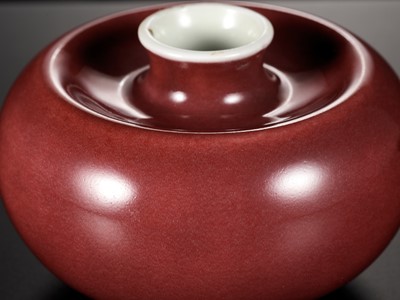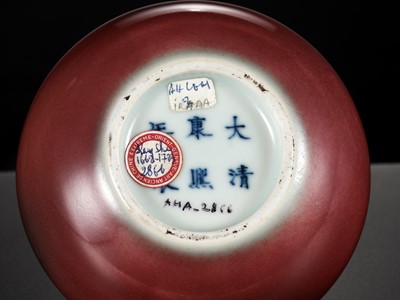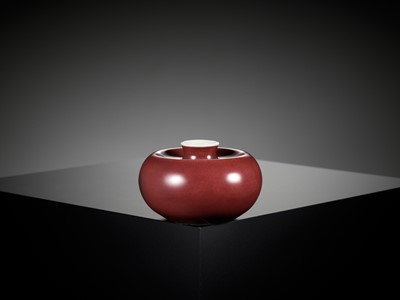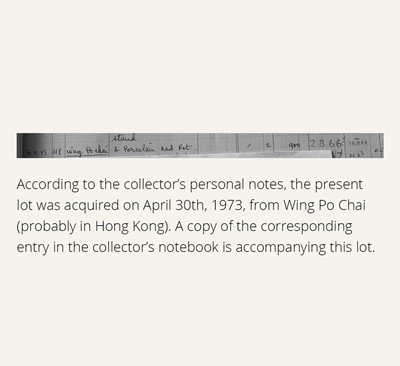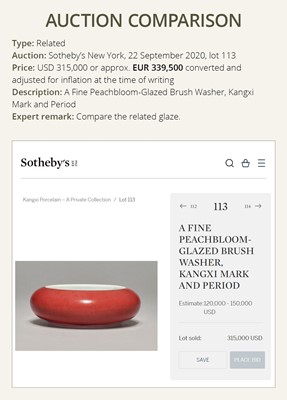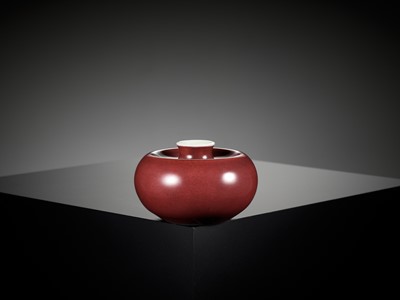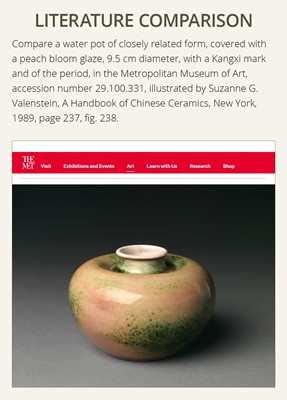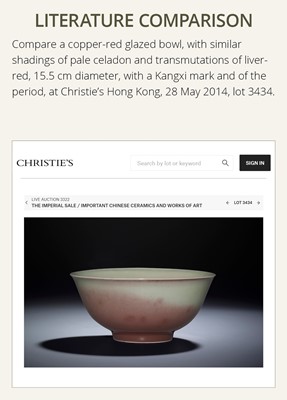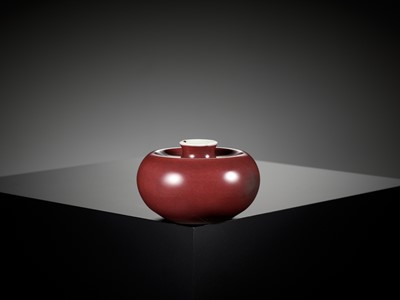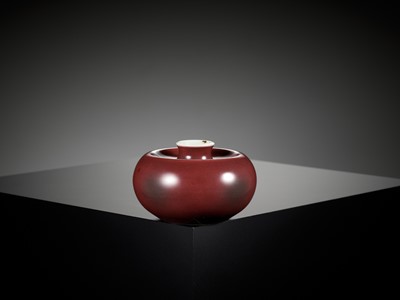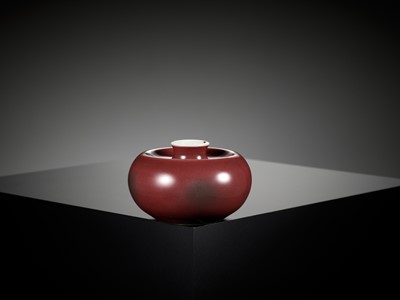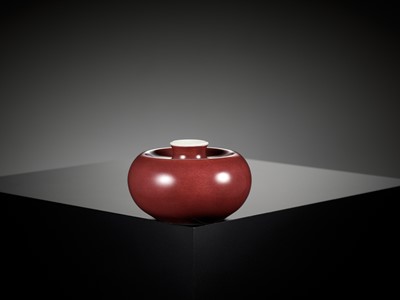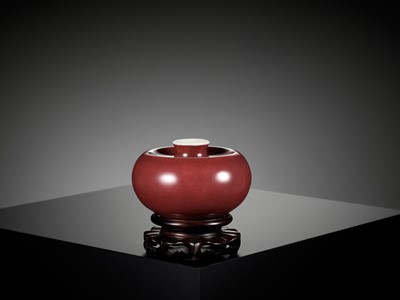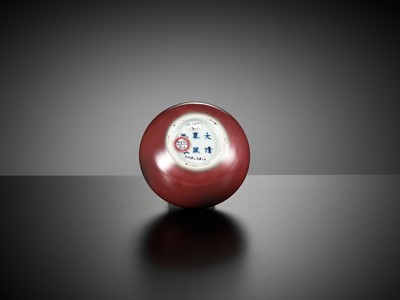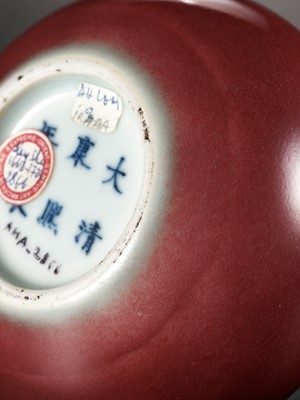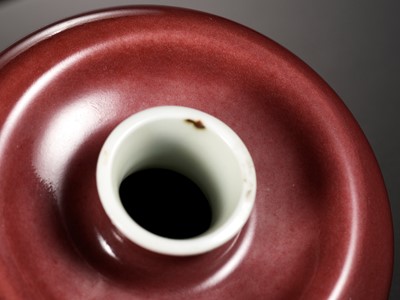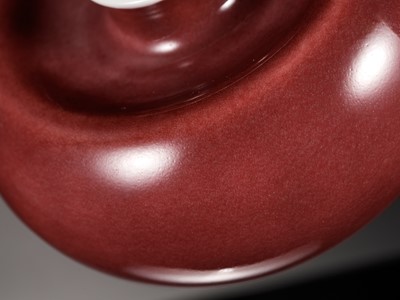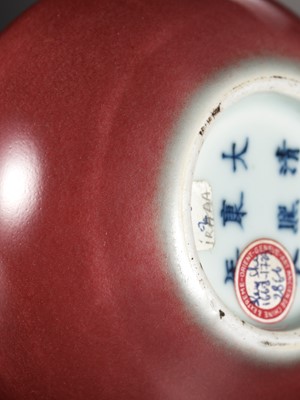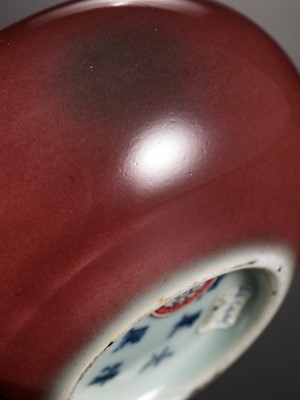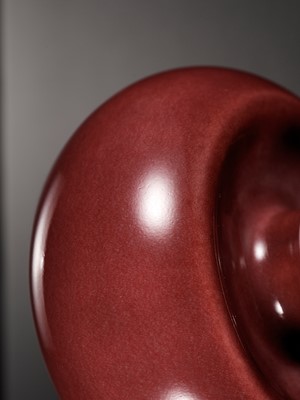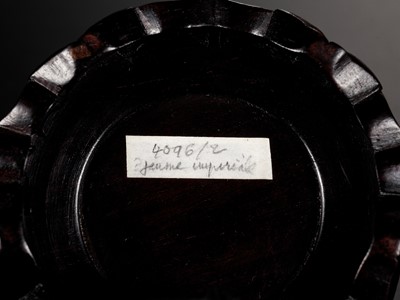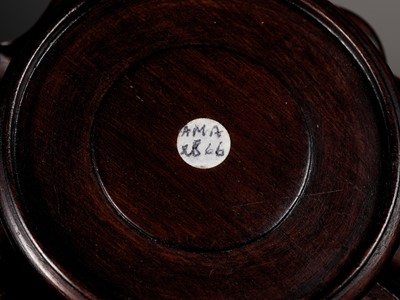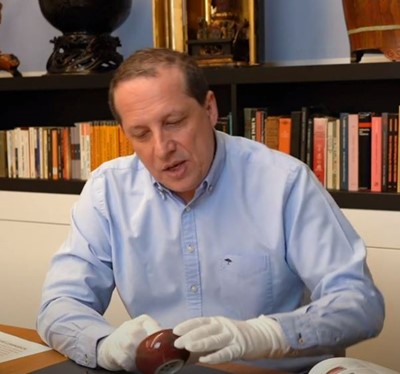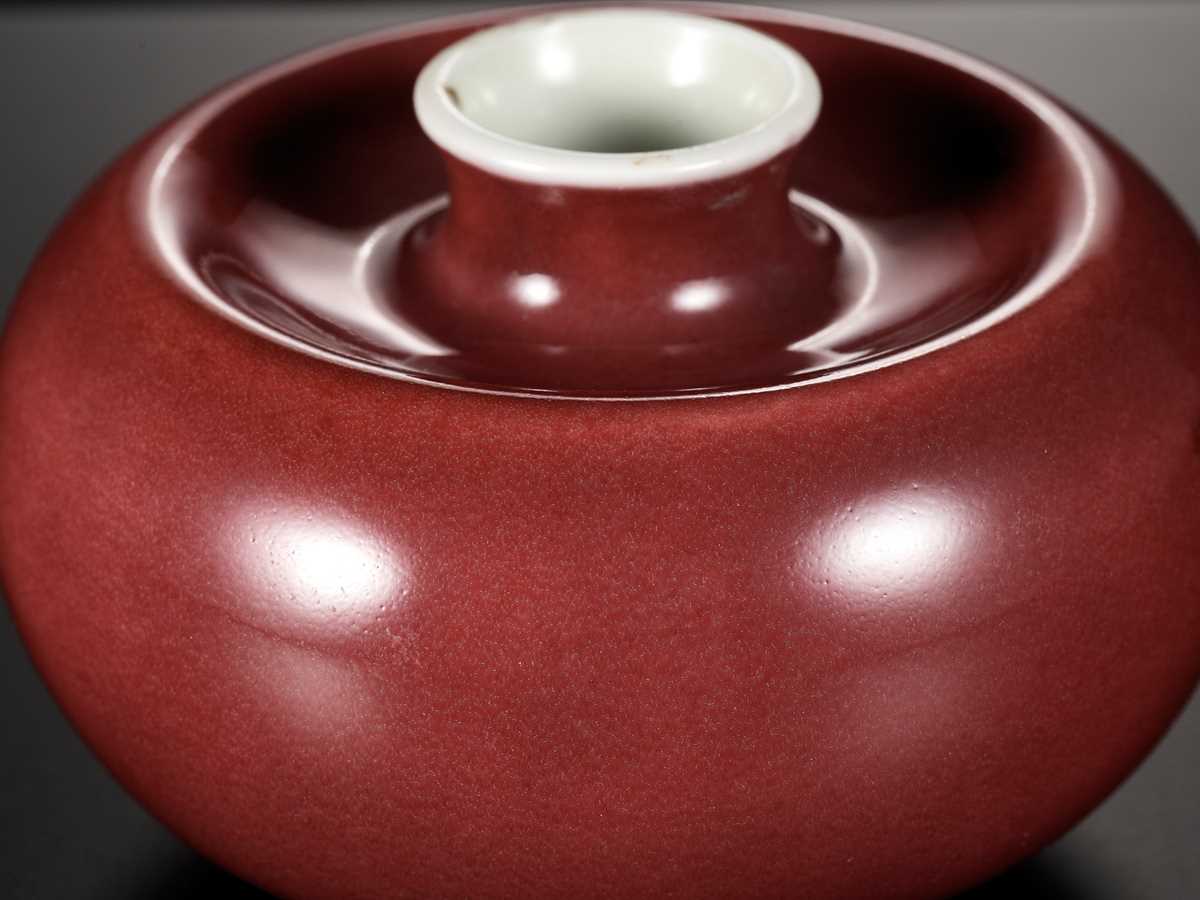9th Mar, 2023 13:00
TWO-DAY AUCTION - Fine Chinese Art / 中國藝術集珍 / Buddhism & Hinduism
101
A RARE COPPER-RED GLAZED WATER POT, PINGGUO ZUN, KANGXI MARK AND PROBABLY OF THE PERIOD (1662–1722)
康熙款罕見釉裏紅蘋果尊,或爲其年代
Sold for €5,200
including Buyer's Premium
Expert’s note: The present lot clearly distinguishes itself from the usual late 19th century wares by its magnificent crushed strawberry glaze, which is well-controlled and even, only mutating to a fine liver tone in two distinct areas. Also note the remarkable pale celadon corona circling the foot, another obvious hallmark of an early 18th-century glaze.
Of classic pingguo zun form, the compressed globular body deeply depressed after the wide shoulders to create an overturned channel and rising to a low waisted neck and lipped rim. The exterior covered with a rich glaze of crushed-strawberry tone thinning to a paler shade at the shoulder and to a distinct pale celadon corona circling the foot, the sides with two circular patches of a darker liver-red tone. The rim, interior, and base covered in a transparent glaze. The recessed base with an underglaze-blue six-character mark da Qing Kangxi nianzhi and probably of the period.
Provenance: From a noted private collection in Geneva, Switzerland, assembled since the 1960s, and thence by descent. An important part of this collection was on permanent loan and exhibited over several decades at the Asia-Africa Museum in Geneva. The base lacquered with an old inventory number, ‘AMA-2866’, and further with two old labels, one reading ‘Art Ancien de Chine & Extrême-Orient Genève. Kang Shi. 1662-1722. 2866’ and the other inscribed with further inventory numbers. The wood stand with two old labels, ‘AMA 2866’ and ‘4096/2 […] imperiale’. According to the collector’s personal notes, the present lot was acquired on 30 April 1973 from Wing Po Chai (probably in Hong Kong). A copy of the corresponding entry in the collector’s notebook accompanies this lot.
Condition: Very good condition with expected old wear and minor firing irregularities, minute fritting and small smoothened areas to the foot, probably inherent to the manufacture. The glaze with an unctuous feel and subtle luster overall.
Weight: 249.6 g (excl. stand)
Dimensions: Diameter 9.5 cm (at the widest points)
With a finely carved and open worked wood stand. (2)
Water pots for washing brushes were designed to be placed on a Chinese scholar's desk. This form is known as pingguo zun (apple jar), of which there are two variations: ones with a short waisted neck and lipped rim, such as the present lot, and ones with an incurved rounded neck. The form of the present lot is the classic, earlier, and considerably rarer variation.
The use of copper-red glaze at Jingdezhen was revived by the Kangxi Emperor after a decline in usage during the late 15th century. With the effort to reproduce classic Ming jihong ('sacrificial red') porcelains, Qing copper-red pieces quickly outnumbered their Ming counterparts. Nigel Wood in Chinese Glazes, London, 1999, p. 180, notes how the French Jesuit missionary, François Xavier d’Entrecolles (1664-1741), wrote letters giving detailed accounts of the copper-red production at Jingdezhen, the sourcing of the copper for the glaze, the recipes and the kiln location of the firing of these wares. Père d’Entrecolles was aware of the difficulties involved in the making of copper-red wares and his account confirms the high level of technical knowledge of the potters at Jingdezhen.
Literature comparison:
Compare a water pot of closely related form, covered with a peach bloom glaze, 9.5 cm diameter, with a Kangxi mark and of the period, in the Metropolitan Museum of Art, accession number 29.100.331, illustrated by Suzanne G. Valenstein, A Handbook of Chinese Ceramics, New York, 1989, page 237, fig. 238. Compare a copper-red glazed bowl, with similar shadings of pale celadon and transmutations of liver-red, 15.5 cm diameter, with a Kangxi mark and of the period, at Christie’s Hong Kong, 28 May 2014, lot 3434.
Auction result comparison:
Type: Related
Auction: Sotheby’s New York, 22 September 2020, lot 113
Price: USD 315,000 or approx. EUR 339,500 converted and adjusted for inflation at the time of writing
Description: A Fine Peachbloom-Glazed Brush Washer, Kangxi Mark and Period
Expert remark: Compare the related glaze.
康熙款罕見釉裏紅蘋果尊,或爲其年代
小口外撇,肩部凹下,鼓腹,圈足。通體覆蓋著紅釉,在肩部處逐漸變淡為淺色,兩側有兩個圓形的深紅色斑塊。 口沿和底足白釉。圈足内青花“大清康熙年製“六字款,或為這一時期。
專家注釋:本拍品與十九世紀末常見的瓷器明顯不同,其華麗的紅釉控制得當,均勻,僅在兩個不同的區域轉變為細膩的牛肝紅色。另請注意環繞足部的顯著淡青色暈圈,這是十八世紀早期釉料的另一個明顯標誌。
來源:瑞士日內瓦知名私人收藏,自 1960 年代開始收集,保存至今。該收藏的一個重要部分被永久借出,並在日內瓦的亞非博物館展出了幾十年。底部有一個老庫存編號‘AMA-2866’,另外有兩個標籤‘Art Ancien de Chine & Extrême-Orient Genève. Kang Shi. 1662-1722. 2866’ 與其他庫存編號。木底座上有兩個標籤 ‘AMA 2866’ 與 ‘4096/2 […] imperiale’. 根據藏家個人記錄,這件拍品于1973年4月30日購於榮寶齋 (可能在香港). 隨附一份進入收藏的庫存單複印件。
品相:狀況極好,有磨損和輕微燒製不規則、微小磨損和足部的小光滑區域,釉色潤潤,整體光澤微妙。
重量:249.6 克 (不含底座)
尺寸:直徑9.5 厘米 (最寬處)
木底座鏤空雕刻。 (2)
銅紅釉在十五世紀後期使用量下降後,康熙皇帝在景德鎮又恢復了使用。隨著努力複製經典的明代祭紅釉瓷器,清代銅紅瓷器的數量迅速超過了明代。Nigel Wood 在Chinese Glazes,倫敦,1999年,頁180,注意到法國耶穌會傳教士 François Xavier d'Entrecolles (1664-1741)寫信詳細說明景德鎮的銅紅釉的來源、配方和窯址。Père d’Entrecolles 知道製作紅銅器的困難,他的敘述證實了景德鎮陶工的高水平技術知識。
文獻比較:
比較一件非常相近外形的康熙款及年代水蜜桃釉蘋果尊,直徑9.5 厘米,收藏於大都會藝術博物館,館藏編號29.100.331,見Suzanne G. Valenstein,《A Handbook of Chinese Ceramics》,紐約,1989年,頁237,圖238。比較一件康熙款及年代釉裏紅蘋果尊,直徑15.5 厘米,售於香港佳士得,2014年5月28日,lot 3434。
拍賣結果比較:
形制:相近
拍賣:紐約蘇富比,2020年9月22日,lot 113
價格:USD 315,000(相當於今日EUR 339,500)
描述:清康熙豇豆紅釉鏜鑼洗 《大清康熙年製》款
專家評論:比較相近釉面。
#byimperialcommand
Expert’s note: The present lot clearly distinguishes itself from the usual late 19th century wares by its magnificent crushed strawberry glaze, which is well-controlled and even, only mutating to a fine liver tone in two distinct areas. Also note the remarkable pale celadon corona circling the foot, another obvious hallmark of an early 18th-century glaze.
Of classic pingguo zun form, the compressed globular body deeply depressed after the wide shoulders to create an overturned channel and rising to a low waisted neck and lipped rim. The exterior covered with a rich glaze of crushed-strawberry tone thinning to a paler shade at the shoulder and to a distinct pale celadon corona circling the foot, the sides with two circular patches of a darker liver-red tone. The rim, interior, and base covered in a transparent glaze. The recessed base with an underglaze-blue six-character mark da Qing Kangxi nianzhi and probably of the period.
Provenance: From a noted private collection in Geneva, Switzerland, assembled since the 1960s, and thence by descent. An important part of this collection was on permanent loan and exhibited over several decades at the Asia-Africa Museum in Geneva. The base lacquered with an old inventory number, ‘AMA-2866’, and further with two old labels, one reading ‘Art Ancien de Chine & Extrême-Orient Genève. Kang Shi. 1662-1722. 2866’ and the other inscribed with further inventory numbers. The wood stand with two old labels, ‘AMA 2866’ and ‘4096/2 […] imperiale’. According to the collector’s personal notes, the present lot was acquired on 30 April 1973 from Wing Po Chai (probably in Hong Kong). A copy of the corresponding entry in the collector’s notebook accompanies this lot.
Condition: Very good condition with expected old wear and minor firing irregularities, minute fritting and small smoothened areas to the foot, probably inherent to the manufacture. The glaze with an unctuous feel and subtle luster overall.
Weight: 249.6 g (excl. stand)
Dimensions: Diameter 9.5 cm (at the widest points)
With a finely carved and open worked wood stand. (2)
Water pots for washing brushes were designed to be placed on a Chinese scholar's desk. This form is known as pingguo zun (apple jar), of which there are two variations: ones with a short waisted neck and lipped rim, such as the present lot, and ones with an incurved rounded neck. The form of the present lot is the classic, earlier, and considerably rarer variation.
The use of copper-red glaze at Jingdezhen was revived by the Kangxi Emperor after a decline in usage during the late 15th century. With the effort to reproduce classic Ming jihong ('sacrificial red') porcelains, Qing copper-red pieces quickly outnumbered their Ming counterparts. Nigel Wood in Chinese Glazes, London, 1999, p. 180, notes how the French Jesuit missionary, François Xavier d’Entrecolles (1664-1741), wrote letters giving detailed accounts of the copper-red production at Jingdezhen, the sourcing of the copper for the glaze, the recipes and the kiln location of the firing of these wares. Père d’Entrecolles was aware of the difficulties involved in the making of copper-red wares and his account confirms the high level of technical knowledge of the potters at Jingdezhen.
Literature comparison:
Compare a water pot of closely related form, covered with a peach bloom glaze, 9.5 cm diameter, with a Kangxi mark and of the period, in the Metropolitan Museum of Art, accession number 29.100.331, illustrated by Suzanne G. Valenstein, A Handbook of Chinese Ceramics, New York, 1989, page 237, fig. 238. Compare a copper-red glazed bowl, with similar shadings of pale celadon and transmutations of liver-red, 15.5 cm diameter, with a Kangxi mark and of the period, at Christie’s Hong Kong, 28 May 2014, lot 3434.
Auction result comparison:
Type: Related
Auction: Sotheby’s New York, 22 September 2020, lot 113
Price: USD 315,000 or approx. EUR 339,500 converted and adjusted for inflation at the time of writing
Description: A Fine Peachbloom-Glazed Brush Washer, Kangxi Mark and Period
Expert remark: Compare the related glaze.
康熙款罕見釉裏紅蘋果尊,或爲其年代
小口外撇,肩部凹下,鼓腹,圈足。通體覆蓋著紅釉,在肩部處逐漸變淡為淺色,兩側有兩個圓形的深紅色斑塊。 口沿和底足白釉。圈足内青花“大清康熙年製“六字款,或為這一時期。
專家注釋:本拍品與十九世紀末常見的瓷器明顯不同,其華麗的紅釉控制得當,均勻,僅在兩個不同的區域轉變為細膩的牛肝紅色。另請注意環繞足部的顯著淡青色暈圈,這是十八世紀早期釉料的另一個明顯標誌。
來源:瑞士日內瓦知名私人收藏,自 1960 年代開始收集,保存至今。該收藏的一個重要部分被永久借出,並在日內瓦的亞非博物館展出了幾十年。底部有一個老庫存編號‘AMA-2866’,另外有兩個標籤‘Art Ancien de Chine & Extrême-Orient Genève. Kang Shi. 1662-1722. 2866’ 與其他庫存編號。木底座上有兩個標籤 ‘AMA 2866’ 與 ‘4096/2 […] imperiale’. 根據藏家個人記錄,這件拍品于1973年4月30日購於榮寶齋 (可能在香港). 隨附一份進入收藏的庫存單複印件。
品相:狀況極好,有磨損和輕微燒製不規則、微小磨損和足部的小光滑區域,釉色潤潤,整體光澤微妙。
重量:249.6 克 (不含底座)
尺寸:直徑9.5 厘米 (最寬處)
木底座鏤空雕刻。 (2)
銅紅釉在十五世紀後期使用量下降後,康熙皇帝在景德鎮又恢復了使用。隨著努力複製經典的明代祭紅釉瓷器,清代銅紅瓷器的數量迅速超過了明代。Nigel Wood 在Chinese Glazes,倫敦,1999年,頁180,注意到法國耶穌會傳教士 François Xavier d'Entrecolles (1664-1741)寫信詳細說明景德鎮的銅紅釉的來源、配方和窯址。Père d’Entrecolles 知道製作紅銅器的困難,他的敘述證實了景德鎮陶工的高水平技術知識。
文獻比較:
比較一件非常相近外形的康熙款及年代水蜜桃釉蘋果尊,直徑9.5 厘米,收藏於大都會藝術博物館,館藏編號29.100.331,見Suzanne G. Valenstein,《A Handbook of Chinese Ceramics》,紐約,1989年,頁237,圖238。比較一件康熙款及年代釉裏紅蘋果尊,直徑15.5 厘米,售於香港佳士得,2014年5月28日,lot 3434。
拍賣結果比較:
形制:相近
拍賣:紐約蘇富比,2020年9月22日,lot 113
價格:USD 315,000(相當於今日EUR 339,500)
描述:清康熙豇豆紅釉鏜鑼洗 《大清康熙年製》款
專家評論:比較相近釉面。
#byimperialcommand
Zacke Live Online Bidding
Our online bidding platform makes it easier than ever to bid in our auctions! When you bid through our website, you can take advantage of our premium buyer's terms without incurring any additional online bidding surcharges.
To bid live online, you'll need to create an online account. Once your account is created and your identity is verified, you can register to bid in an auction up to 12 hours before the auction begins.
Intended Spend and Bid Limits
When you register to bid in an online auction, you will need to share your intended maximum spending budget for the auction. We will then review your intended spend and set a bid limit for you. Once you have pre-registered for a live online auction, you can see your intended spend and bid limit by going to 'Account Settings' and clicking on 'Live Bidding Registrations'.
Your bid limit will be the maximum amount you can bid during the auction. Your bid limit is for the hammer price and is not affected by the buyer’s premium and VAT. For example, if you have a bid limit of €1,000 and place two winning bids for €300 and €200, then you will only be able to bid €500 for the rest of the auction. If you try to place a bid that is higher than €500, you will not be able to do so.
Online Absentee and Telephone Bids
You can now leave absentee and telephone bids on our website!
Absentee Bidding
Once you've created an account and your identity is verified, you can leave your absentee bid directly on the lot page. We will contact you when your bids have been confirmed.
Telephone Bidding
Once you've created an account and your identity is verified, you can leave telephone bids online. We will contact you when your bids have been confirmed.
Classic Absentee and Telephone Bidding Form
You can still submit absentee and telephone bids by email or fax if you prefer. Simply fill out the Absentee Bidding/Telephone bidding form and return it to us by email at office@zacke.at or by fax at +43 (1) 532 04 52 20. You can download the PDF from our Upcoming Auctions page.
How-To Guides
How to Create Your Personal Zacke Account
How to Register to Bid on Zacke Live
How to Leave Absentee Bids Online
How to Leave Telephone Bids Online
中文版本的操作指南
创建新账号
注册Zacke Live在线直播竞拍(免平台费)
缺席投标和电话投标
Third-Party Bidding
We partner with best-in-class third-party partners to make it easy for you to bid online in the channel of your choice. Please note that if you bid with one of our third-party online partners, then there will be a live bidding surcharge on top of your final purchase price. You can find all of our fees here. Here's a full list of our third-party partners:
- 51 Bid Live
- EpaiLive
- ArtFoxLive
- Invaluable
- LiveAuctioneers
- the-saleroom
- lot-tissimo
- Drouot
Please note that we place different auctions on different platforms. For example, in general, we only place Chinese art auctions on 51 Bid Live.
Bidding in Person
You must register to bid in person and will be assigned a paddle at the auction. Please contact us at office@zacke.at or +43 (1) 532 04 52 for the latest local health and safety guidelines.
